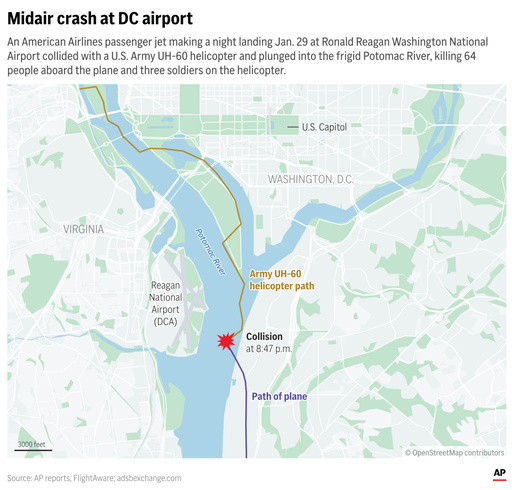
The United States Army, along with 27 other federal agencies, had been permitted to operate helicopters in the vicinity of Ronald Reagan National Airport prior to last week’s tragic incident where a Black Hawk helicopter collided with an American Airlines jet, resulting in 67 fatalities. Investigators are currently scrutinizing various elements of this ongoing operation, particularly the helicopter’s breach of a 200-foot altitude limitation. They are also recovering debris from both aircraft while trying to ascertain the reasons behind the helicopter’s deviation from prescribed flight regulations.
New findings indicate that there are no specific rules governing how far helicopters can fly from the airport, either over land or water. An interview with a high-ranking Army aviation official has shed more light on the situation, revealing the strains faced by the military unit involved in the accident.
The 12th Aviation Battalion, which operates out of Davison Army Air Field in Fort Belvoir, Virginia, has a classified mission that requires it to ensure government continuity by safely transporting key officials during emergencies. This battalion’s resources are currently under pressure, both in terms of available aircraft and personnel, as its fleet includes aging Black Hawk helicopters.
Out of approximately 100 older UH-60L Black Hawks in the Army’s possession, eight were allocated to the battalion prior to the accident, leaving only seven operational after the crash. In addition, the battalion possesses six newer UH-60M helicopters, referred to as “gold tops.”
According to Jennifer Homendy, the Chair of the National Transportation Safety Board (NTSB), the helicopter crew was likely donning night vision goggles when the collision occurred. Investigators analyzing data from the cockpit voice recorder did not hear any indications that the crew was flying without these devices, which they would have mentioned if they were not in use. Brig. Gen. Matthew Braman, Director of Army Aviation, commented that pilots generally decide on the use of goggles, but if one crew member is wearing them, all are required to do the same.
While night vision goggles assist in low-light conditions, they can also complicate depth perception, making it harder for crews to accurately gauge distances. Braman pointed out that Army aviators are trained to deal with these challenges and are instructed to momentarily look outside the goggles for better situational awareness.
After the NTSB briefing, Senator Ted Cruz from Texas noted that investigators mentioned the Black Hawk’s Automatic Dependent Surveillance-Broadcast (ADS-B) system was reportedly turned off. This technology is crucial for tracking an aircraft’s position and altitude, and according to Cruz, there wasn’t a strong national security reason for it to be disabled during a training mission.
Braman also indicated that the Army’s 12th Aviation Battalion is among 28 entities utilizing low-altitude helicopter corridors around Reagan National Airport, including various governmental agencies and emergency services. Since the recent accident, the Federal Aviation Administration (FAA) has restricted helicopter traffic in the area, prompting the Army to look for alternative routes for its operations.
Gabe Evans, a Colorado Representative and former Black Hawk pilot, emphasized the need to balance the demands of air traffic control with public safety. Although the guidelines state that helicopters using these routes along the Potomac River must not exceed a height of 200 feet, there are currently no lateral restrictions outlined by the FAA on where these helicopters can fly over land or water. This absence of guidelines may soon change as the investigation continues.
The collision is believed to have transpired at an altitude of around 325 feet, raising alarms about the Black Hawk’s flight height exceeding permissible limits. Investigators are seeking explanations for this discrepancy, including verifying whether the barometric altitude readings were correct. In older Black Hawk models, pilots must manually calibrate the altitude settings before departing, but if the altimeter shows a significant deviation from the airfield’s reported altitude, the aircraft is deemed unfit for flight.
The cockpit features two systems for altitude awareness; the barometric altimeter relies on air pressure, while the radar altimeter provides real-time height data by sending radio signals to the ground. As investigators analyze voice recordings from the cockpit, they will establish if the altimeter readings were accurate during the flight. Notably, many older Army helicopters, including the UH-60L variants, lack modern collision avoidance systems due to their inefficacy at lower altitudes. Braman stated that, even if the Black Hawk had remained at the required altitude, a commercial aircraft landing above it at 200 feet would still pose a significant safety risk, suggesting that additional safety measures should have been implemented.

